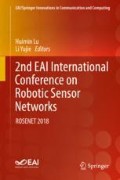Abstract
Nearest-neighbor diffusion pan sharpening, as a new image fusion method based on nearest-neighbor diffusion, has become a new hot spot of research. In this paper, the nearest-neighbor diffusion pan sharpening method is used for a WorldView-2 image fusion experiment and compared with the methods we usually use such as the wavelet transform fusion method, the PCA transform fusion method, and the Gram–Schmidt transform fusion method. The experimental results show that the spatial information is better than the other three methods in terms of spatial details and texture.
Access this chapter
Tax calculation will be finalised at checkout
Purchases are for personal use only
References
Liu, Z., Blasch, E., & John, V. (2017). Statistical comparison of image fusion algorithms: Recommendations. Information Fusion, 36, 251–260.
Huimin, L., Li, Y., Shota, N., Hyongseop, K., & Seiichi, S. (2013). Principles and methods of remote sensing application analysis. Beijing: Science Press.
Chen, C., Qin, Q., Wang, J., et al. (2011). Comparison of quality evaluation methods for image fusion of farmland remote sensing. Transactions of the CSAE, 27(10), 95–100.
Wang, L., Niu, X., Wei, B., et al. (2015). Study on quality evaluation methods for remotely sensed images fusion. Bulletin of Surveying and Mapping, 2, 77–79.
Li, Y., Lu, H., Li, J., et al. (2016). Underwater image de-scattering and classification by deep neural network. Computers and Electrical Engineering, 54, 68–77.
Lu, H., Li, Y., Nakashima, S., et al. (2016). Turbidity underwater image restoration using spectral properties and light compensation. IEICE Transactions on Information and Systems, 99(1), 219–227.
Lu, H., Li, Y., Zhang, L., & Serikawa, S. (2015). Contrast enhancement for images in turbid water. Journal of the Optical Society of America A, 32(5), 886–893.
Lu, H., Li, Y., Zhang, Y., et al. (2017). Underwater optical image processing: A comprehensive review. Mobile Networks and Applications, 22(6), 1204–1211.
Chen, M., Hao, Y., Qiu, M., et al. (2016). Mobility-aware caching and computation offloading in 5G ultra-dense cellular networks. Sensors, 16, 974.
Chen, M., Yang, J., Hao, Y., et al. (2017). A 5G cognitive system for healthcare. Big Data and Cognitive Computing, 1, 2. https://doi.org/10.3390/bdcc1010002.
Chen, M., Shi, X., Zhang, Y., et al. (2017). Deep feature learning for medical image analysis with convolutional autoencoder neural network. IEEE Transactions on Big Data. https://doi.org/10.1109/TBDATA.2017.2717439
Sun, W., & Messinger, D. (2014). Nearest-neighbor diffusion-based pan-sharpening algorithm for spectral images. Optical Engineering, 53(1), 013107.
Shannon, C. E. (2014). A mathematical theory of communication. Bell System Technical Journal, 27(3), 379–423.
Rodgers, J. L., & Nicewander, W. A. (1988). Thirteen ways to look at the correlation coefficient. The American Statistician, 42(1), 59–66.
Schwartz, M. H., & Rozumalski, A. (2008). The gait deviation index: A new comprehensive index of gait pathology. Gait and Posture, 28(3), 351–357.
Bennis, D., Garcia Rozas, J. R., & Oyonarte, L. (2016). Relative Gorenstein global dimension. International Journal of Algebra and Computation, 26(8), 1597–1615.
Acknowledgments
This research is supported by the key research project fund of the Institution of Higher Education in Henan Province (18A420001), the Henan Polytechnic University Doctoral Fund (B2016-13), and The Open Program of the Collaborative Innovation Center of Geo-Information Technology for Smart Central Plains, Henan Province (2016A002).
Author information
Authors and Affiliations
Editor information
Editors and Affiliations
Rights and permissions
Copyright information
© 2020 Springer Nature Switzerland AG
About this paper
Cite this paper
Wang, C., Shao, W., Lu, H., Zhang, H., Wang, S., Yue, H. (2020). Research into the Adaptability Evaluation of the Remote Sensing Image Fusion Method Based on Nearest-Neighbor Diffusion Pan Sharpening. In: Lu, H., Yujie, L. (eds) 2nd EAI International Conference on Robotic Sensor Networks. EAI/Springer Innovations in Communication and Computing. Springer, Cham. https://doi.org/10.1007/978-3-030-17763-8_4
Download citation
DOI: https://doi.org/10.1007/978-3-030-17763-8_4
Published:
Publisher Name: Springer, Cham
Print ISBN: 978-3-030-17762-1
Online ISBN: 978-3-030-17763-8
eBook Packages: EngineeringEngineering (R0)

